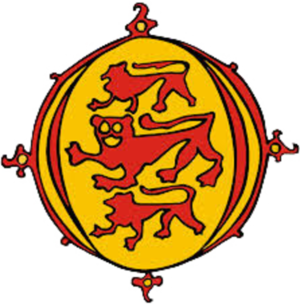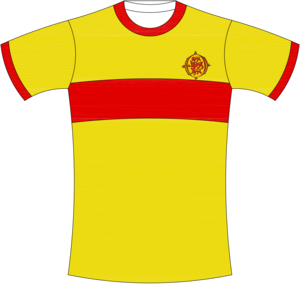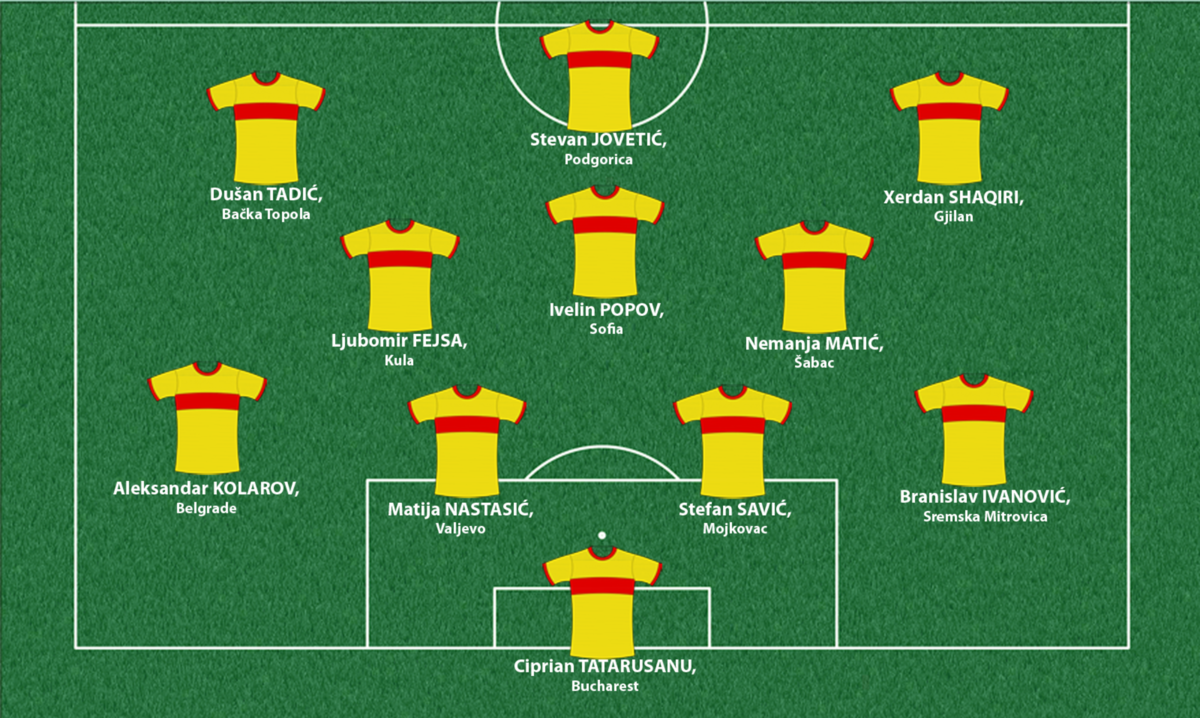The Bulgarian Empire
In the first decades of the 10th century Bulgarian rulers will create a enormous Empire in the area of South East Europe from the Black Sea to the Peloponnese. Of course, the name of Bulgaria was not spread on that territory, neither its inhabitants were (only) Bulgarians.

Coat of arms

Shirt
| Position | First name | Last name | Mjesto rođenja | Like | Dislike | |
|---|---|---|---|---|---|---|
| GK | Ciprian | TATARUSANU | Bucharest |
21 |
7 |
|
| GK | Etrit | BERISHA | Pristina |
17 |
26 |
|
| DC | Matija | NASTASIĆ | Valjevo |
63 |
6 |
|
| DC | Nikola | MILENKOVIĆ | Belgrade |
18 |
7 |
|
| DC | Stefan | SAVIĆ | Mojkovac |
46 |
5 |
|
| DC | Vlad | CHIRICHES | Bacău |
5 |
3 |
|
| DRC | Branislav | IVANOVIĆ | Sremska Mitrovica |
43 |
15 |
|
| DLC | Stefan | RADU | Bucharest |
21 |
6 |
|
| DRLC | Nenad | TOMOVIĆ | Kragujevac |
22 |
6 |
|
| DR/MR | Strahil | POPOV | Blagoewgrad |
11 |
9 |
|
| DL/ML | Aleksandar | KOLAROV | Belgrade |
45 |
13 |
|
| DMC | Ljubomir | FEJSA | Kula |
9 |
11 |
|
| DMC | Luka | MILIVOJEVIĆ | Kragujevac |
30 |
9 |
|
| DMC | Nemanja | MATIĆ | Vrelo |
60 |
10 |
|
| DMC | Nemanja | RADOJA | Novi Sad |
4 |
2 |
|
| MC | Marko | GRUJIĆ | Belgrade |
13 |
3 |
|
| MC | Nikola | MAKSIMOVIĆ | Belgrade |
27 |
14 |
|
| MC | Zlatko | JUNUZOVIĆ | Loznica |
11 |
9 |
|
| AMRLC | Adem | LJAJIĆ | Novi Pazar |
23 |
4 |
|
| AMRLC | Georgi | MILANOV | Levski |
10 |
1 |
|
| AMRLC | Ivelin | POPOV | Sofia |
10 |
2 |
|
| AMRLC | Kostas | FORTOUNIS | Trikala |
23 |
10 |
|
| AMRLC | Nicolae | STANCIU | Alba Iulia |
10 |
11 |
|
| AMRL | Filip | KOSTIĆ | Kragujevac |
29 |
9 |
|
| AMRL | Lazar | MARKOVIĆ | Čačak |
18 |
7 |
|
| AMRL | Xerdan | SHAQIRI | Gjilan |
44 |
26 |
|
| SS/FC | Stevan | JOVETIĆ | Podgorica |
30 |
8 |
|
| FRLC | Admir | MEHMEDI | Gostivar |
5 |
15 |
|
| FRLC | Uroš | ĐURĐEVIĆ | Belgrade |
8 |
8 |
|
| FC | Aleksandar | MITROVIĆ | Smederevo |
31 |
10 |
|
| FC | Ilija | NESTOROVSKI | Prilep |
24 |
5 |
|
| FC | Konstantinos | MITROGLOU | Kavala |
7 |
4 |
Today part of: Bulgaria, Romania, Republic of Macedonia, Moldavia, Serbia, central, nothern and eastern Greece (without Thessaloníki), Montenegro, Albania (without coast)
By the end of the 7h century, the areas of Moesia and Dacia, formally under Byzantine rule, had fallen into the hands of a less-than-numerous martial people of Turkic origins – the Bulgarians. Coming from Asia, the Bulgarians, as a territorial elite, had subdued and ruled over the Slavic majority in those parts, who had not had any kind of organized political system, but whose language soon became the state language, and the Bulgarian elite itself had Slavicized by the 10th century. During the 60s of the 9th century, Boris I (ruled 857 – 888), introduced Christianity along with Slavic liturgy, and the Glagolitic alphabet. At first, he embraced Catholicism, and then Orthodoxy, because the pope had refused to approbate his Archbishopric. Since those times they expanded into Byzantine lands, although it would appear that Hungarians had been their biggest enemies at the time.
Under Simeon (ruled 893 – 927), the Bulgarian Empire threatened to take the military and political primacy away from Byzantium, against whom he had led two prolonged wars (894 – 899; 912 – 924). It is assumed that his empire had, at its peak, spread from the Black Sea in the east, to approximately the Drina and the Ionic Sea in the west, the Peloponnese and the shores of the Aegean Sea in the south, to the Danube in the north, while it also controlled the areas north of it. Of course, all areas along the borders were exposed to further threats of being conquered. Simeon took the title of “the Emperor of Bulgarians and Romaioi” (917 AD); nevertheless, he was never able to conquer Constantinople.In order to emphasize Bulgarian independence in the religious sense, he had named the metropolitan in Preslav patriarch, and created ties between himself and the pope. The empire declined during the reigns of his successors, under Pecheneg and Hungarian attacks, and in mid-10th century it became the scene of conflict between the great prince of Kiev and the Byzantine emperor that ended in the victory of the latter, but also in the loss of Bulgarian independence (971 AD).
Sources
- Felipe FERNANDEZ-ARMESTO, Narodi Europe, Zagreb, 1997.
- Grupa autora, Povijest: Rani i razvijeni srednji vijek , knjiga VI., Zagreb 2008.
- Jacques LE GOFF, Civilizacija srednjovjekovnog Zapada, Zagreb 1998.
- Mirna GLAVAN, ''Samuilova država'', (http://povijest.net/samuilova-drzava/)
- ''Simeon I of Bulgaria'', https://en.wikipedia.org/wiki/Simeon_I_of_Bulgaria#Culture_and_religion
- ''Simeon'', http://www.enciklopedija.hr/Natuknica.aspx?ID=56004
- Coat of Arms:
- https://en.wikipedia.org/wiki/Coat_of_arms_of_Bulgaria
